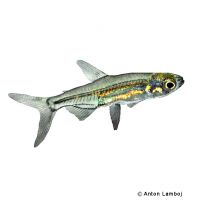Jelly Bean Tetra (Lepidarchus adonis)
| Jelly Bean Tetra Lepidarchus adonis | |
|---|---|
| Name | Jelly Bean Tetra |
| Name Lat. | Lepidarchus adonis |
| Family | African Tetras |
| Family lat. | Alestidae |
| Order | Characins |
| Order lat. | Characiformes |
| Origin | Africa |
| Habitat | Streams, ponds |
| Diet | Carnivore |
| pH | 6.0-7.0 |
| Behavior | Peaceful |
| Keeping | Group |
| Care Level | Difficult |
| Reproduction | Oviparous |
| Breeding | Simple |
| Life Span | 2-5 years |
| Protection | No |
| Metric Units | |
| Size | 2 cm |
| Temperature | 22-25 °C |
| Hardness | 1-7 °dH |
| Aquarium | 50 l |
| US Units | |
| Size | 0.8" |
| Temperature | 72-77 °F |
| Hardness | 18-125 ppm |
| Aquarium | 15 gal |
Distribution and habitat
The distribution areas of the Adonis tetra are small waters in the south of Ghana and the Ivory Coast. There they live in vegetation-rich streams, ponds and small lakes
Maintenance
The aquarium should have a dense planting, with many hiding places (stones, roots), and offer free swimming space. A dark substrate with foliage and some subdued light (floating plants) are ideal, then they also show their most beautiful coloration.
No ammonia, ammonium and nitrite should be detectable, the nitrate value should not exceed 100 mg/l. To ensure the water quality and oxygen content, a filter and heater adapted to the aquarium size is required, as well as lighting for the species-appropriate day-night rhythm of the animals.
Diet
The food supply consists of small live foods, such as daphnia, cyclops, and artemia, which are also eaten without problems in frozen form, plus commercially available, frozen special food mixtures, supplemented with high-quality, fine dry food (flakes, granules), which is well accepted
A regular and varied diet promotes health and increases resistance. Only as much should be fed as is eaten immediately (in a maximum of 10 minutes).
Behaviour and compatibility
They are petite, peaceful and unproblematic schooling fish that should only be socialized with other small, sensitive species. At least 5, but preferably more Adonis tetras should be kept together
Basically, only mutually compatible fish species with similar demands on water conditions and water temperature should be socialized.
Sex dimorphism
Males bear numerous purplish spots on the posterior half of the body and caudal fin, while females are nearly translucent
Reproduction and breeding
They spawn in the open water between tender plants. The larvae hatch after about 35 hours and swim freely after 6 days.
Fry must be fed several times a day with special rearing food (dust food). In a community tank breeding is hardly possible, because the spawn is easy prey.
Important
They belong to the smallest aquarium ornamental fish and have high demands on water quality. The optimal water temperature for Adonis tetras is 23 °C.
The well-being of the fish should be checked regularly. Temperature should be checked daily, pH, hardness and nitrate levels should be checked at least every 14 days. Regular partial water changes are recommended, even if the pollutant load has not yet reached the upper limit. Sudden changes in water quality should be avoided. Newly introduced fish must be accustomed slowly to the water in the aquarium.
Further literature can be found in your pet store.
References
Text: petdata; Image: Anton Lamboj
Source: BMELV (1998): Tierschutzgutachten - Haltung von Zierfischen (Süßwasser); RIEHL & BAENSCH (2002): Aquarien Atlas, Mergus Verlag; ENGELMANN (2005): Fische, Zootierhaltung, Verlag Harri Deutsch
- Gemäß § 21 Abs. 5 Tierschutzgesetz idgF
